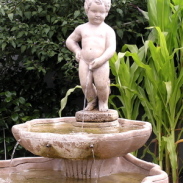- Sanitation systems
- Toilets with urine diversion
- dry toilets in traditional earthen architecture in Mali (Timbuktu, Jenne)
dry toilets in traditional earthen architecture in Mali (Timbuktu, Jenne)
2207 views
- Ecowaters
-
 Less
Less- Posts: 62
- Karma: 1
- Likes received: 9
Re: dry toilets in traditional earthen architecture in Mali (Timbuktu, Jenne)
In Maine, Eric Olsen used human poop in his cob and cob-covered strawbale buildings because it helped create finer bonds with smoother texture.
He intended to use animal manure but used human while waiting to collect cow manure to his friend's farm.
He intended to use animal manure but used human while waiting to collect cow manure to his friend's farm.
Book writer, researcher, workshop presenter, eco-toilet vendor, market transformer
carol-steinfeld.com (personal)
www.ecotoilets.org (soon)
ecotechproducts.net
carol-steinfeld.com (personal)
www.ecotoilets.org (soon)
ecotechproducts.net
Please Log in to join the conversation.
You need to login to replyRe: dry toilets in traditional earthen architecture in Mali (Timbuktu, Jenne)
Hi,
I wanted share an update about the use of feces in the traditional earthen buildings in Jenne and Timbuktu. I learned this from an architect who works with the Aga Khan Development Network, he'd overseen the Earthen Architecture Program in Mali for many years.
https://www.the.akdn/en/where-we-work/west-africa/mali
He said that the masons break into the toilet chamber about every 2 years and remove the feces. The feces are used as a plasticizer, a mix of 5% or so, into the mud mix that they use to replaster the earthen buildings. (They do not use feces on mosques, however.) I had never heard of this type of closed loop practice and think it is really amazing.
I have also learned that the reason feces make the earthen plaster stronger and better is that they repel water. Researchers from TU Delft discovered why cow dung, which is a traditional additive to earthen buildings in many parts of the world, improves the mud mix. It is due to the gut microbes in the feces. Yask Kulshreshtha has published his work on this topic here:
pure.tudelft.nl/ws/files/116184571/CTA.1.540.pdf
www.tudelft.nl/global/stories/building-a...-biowaste-materials/
Does anyone know of other places where human feces are used in earthen building?
I wanted share an update about the use of feces in the traditional earthen buildings in Jenne and Timbuktu. I learned this from an architect who works with the Aga Khan Development Network, he'd overseen the Earthen Architecture Program in Mali for many years.
https://www.the.akdn/en/where-we-work/west-africa/mali
He said that the masons break into the toilet chamber about every 2 years and remove the feces. The feces are used as a plasticizer, a mix of 5% or so, into the mud mix that they use to replaster the earthen buildings. (They do not use feces on mosques, however.) I had never heard of this type of closed loop practice and think it is really amazing.
I have also learned that the reason feces make the earthen plaster stronger and better is that they repel water. Researchers from TU Delft discovered why cow dung, which is a traditional additive to earthen buildings in many parts of the world, improves the mud mix. It is due to the gut microbes in the feces. Yask Kulshreshtha has published his work on this topic here:
pure.tudelft.nl/ws/files/116184571/CTA.1.540.pdf
www.tudelft.nl/global/stories/building-a...-biowaste-materials/
Does anyone know of other places where human feces are used in earthen building?
The following user(s) like this post: HAPitot
Please Log in to join the conversation.
You need to login to replydry toilets in traditional earthen architecture in Mali (Timbuktu, Jenne)
Hi,
I'm looking for information about traditional dry toilets in Sudanese style earthen buildings in Mali (Jenne or Timbuktu). Every reference I find is very basic with no details on how the toilets were emptied or what happened to the material.
Does anyone here know or could point me in the right direction?
This is a description I found about earthen houses in Jenne:
Dry latrines upstairs- Collected liquids carried outside through a pottery pipe to a receptacle emptied daily. Solids collected in a banco receptacle, one of whose walls faces the street, and which is emptied every 2 years.
This article provides all the info I'm looking for, but it's about the M'zab region.
iwaponline.com/washdev/article/11/6/983/...s-and-fecal-nutrient
Thank you for any information you have!
Kind regards,
Laura
I'm looking for information about traditional dry toilets in Sudanese style earthen buildings in Mali (Jenne or Timbuktu). Every reference I find is very basic with no details on how the toilets were emptied or what happened to the material.
Does anyone here know or could point me in the right direction?
This is a description I found about earthen houses in Jenne:
Dry latrines upstairs- Collected liquids carried outside through a pottery pipe to a receptacle emptied daily. Solids collected in a banco receptacle, one of whose walls faces the street, and which is emptied every 2 years.
This article provides all the info I'm looking for, but it's about the M'zab region.
iwaponline.com/washdev/article/11/6/983/...s-and-fecal-nutrient
Thank you for any information you have!
Kind regards,
Laura
Please Log in to join the conversation.
You need to login to reply
Share this thread:
- Sanitation systems
- Toilets with urine diversion
- dry toilets in traditional earthen architecture in Mali (Timbuktu, Jenne)
Recently active users. Who else has been active?
Time to create page: 0.056 seconds







